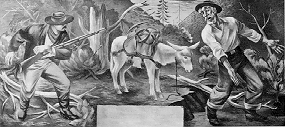Not in harmony with existing conditions
 Collapse of the financial markets has me thinking about which parts of the economy go first. The arts are not first to go, not now, in part because so many artists are already affiliated with institutiona through “regular” jobs and with universities. Once upon a time artists were among the first two or three economic segments to suffer. This isn’t to say that those with regular (non-arts-related) jobs won’t get hurt — only that they will get hurt in the usual order of bad times, sector by sector without respect (and I mean that word) to the arts’ relevance or irrelevance.
Collapse of the financial markets has me thinking about which parts of the economy go first. The arts are not first to go, not now, in part because so many artists are already affiliated with institutiona through “regular” jobs and with universities. Once upon a time artists were among the first two or three economic segments to suffer. This isn’t to say that those with regular (non-arts-related) jobs won’t get hurt — only that they will get hurt in the usual order of bad times, sector by sector without respect (and I mean that word) to the arts’ relevance or irrelevance.
In the 1930s, of course, the government put unemployed artists to work in federal arts projects that included murals for post offices. Many of the post offices had themselves just been designed and built by people who'd been on the dole and picked up work through the New Deal feds.
This meant — famously — that for the first time residents of American bohemia were in more or less direct contact with small-town America. I mean, it’s really the case that federally employed artists were “sent out” to communities to paint murals in what then was one of the few social meetingplaces in such towns, the P.O. This produced quite a convergence, and the social results were mostly good. (Much has been written about this.)
Not often but occasionally local conservatives hated the populist, pro-worker, bottom-up scenes depicted in the murals, or thought the paintings showed too much leg, or in general believed the local culture had been mis-represented.
Residents of Port Washington, New York objected to the artist Paul Cadmus’s designs for the local post office showing the resort town’s summer people engaged in youthful sports, and especially to a girl clad in shorts in a yachting panel. Cadmus reworked his design and put pajamas on the “hot stuff” in the yachting panel.
Westward on the prairie, the Cheyenne Indians pitched a tepee on the lawn of the Watongo, Oklahoma, Post Office until the artist Edith Mahier changed the Indian ponies in her mural which Chief Red Bird said resembled oversized swans and Indian children who looked like cornmeal-bloated pigs.
The artist Joseph Vorst repainted the post office mural in Paris, Arkansas, when local civic groups objected that the lone farmer pushing an antiquated plow in the first mural failed to reflect the progressive nature of the community.
In the mining community of Kellogg, Idaho, Local 18 of the Mine Workers and Smelt Workers praised Fletcher Martin’s dramatic design, “Mine Rescue,” as distinctly appropriate for the post office while local industrialists rejected it as not in harmony with existing conditions. The industrialists carried and Martin eventually installed a noncontroversial scene of purely local interest. At the top of this entry is a reproduction of “Mine Rescue,” the rejected work, and just below is the painting with which Martin replaced it. In Maryland the director of Glendale Children’s Tuberculosis Sanitarium ordered receiving room walls whitewashed after the artist Bernice Cross had decorated them with scenes from Mother Goose. The director considered the work “unsuitable to the dignity of a public institution.”
In Maryland the director of Glendale Children’s Tuberculosis Sanitarium ordered receiving room walls whitewashed after the artist Bernice Cross had decorated them with scenes from Mother Goose. The director considered the work “unsuitable to the dignity of a public institution.”
For more about all this, click here.